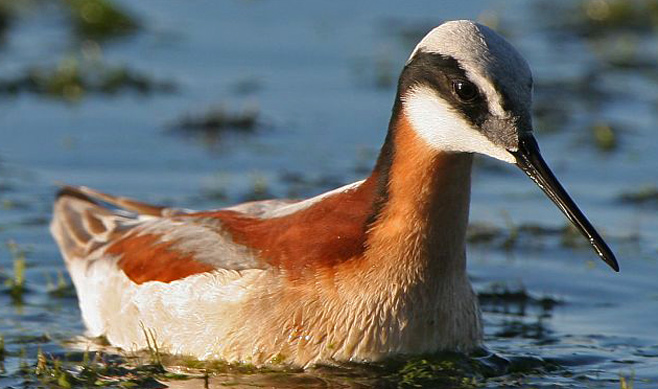|
Steganopus tricolor (Wilson's
phalarope)
[= Phalaropus tricolor]
Bontfraiingpoot [Afrikaans]; Grote franjepoot [Dutch]; Phalarope
de Wilson [French]; Wilsons wassertreter, Amerikanisches odinshühnchen
[German]; Falaropo de Wilson [Portuguese]
Life
> Eukaryotes >
Opisthokonta
> Metazoa (animals) >
Bilateria >
Deuterostomia > Chordata >
Craniata > Vertebrata (vertebrates) > Gnathostomata (jawed
vertebrates) > Teleostomi (teleost fish) > Osteichthyes (bony fish) > Class:
Sarcopterygii (lobe-finned
fish) > Stegocephalia (terrestrial
vertebrates) > Tetrapoda
(four-legged vertebrates) > Reptiliomorpha > Amniota >
Reptilia (reptiles) >
Romeriida > Diapsida > Archosauromorpha > Archosauria >
Dinosauria
(dinosaurs) > Saurischia > Theropoda (bipedal predatory dinosaurs) >
Coelurosauria > Maniraptora > Aves
(birds) >
Order: Charadriiformes > Family: Scolopacidae
 |
|
Wilson's phalarope female in breeding plumage,
Dolphin Beach Pan, South Africa. [photo
Trevor Hardaker ©] |
Distribution and habitat
Breeds in southern Canada and northern USA in the area from
65-30° North, heading south to South America in the non-breeding season to South
America, while it is a rare vagrant to Europe, Australasia and Africa, including
southern Africa. Here it has been recorded about seven times at the coast of
central Namibia, the South-Western Cape, the Eastern Cape and KwaZulu-Natal,
mainly occurring on salt pans.
Food
It mainly eats invertebrates, foraging both in the water
and on land, lunging side to side with its bill to catch prey.
References
-
Hockey PAR, Dean WRJ and Ryan PG 2005. Roberts
- Birds of southern Africa, VIIth ed. The Trustees of the John Voelcker
Bird Book Fund, Cape Town.
|
